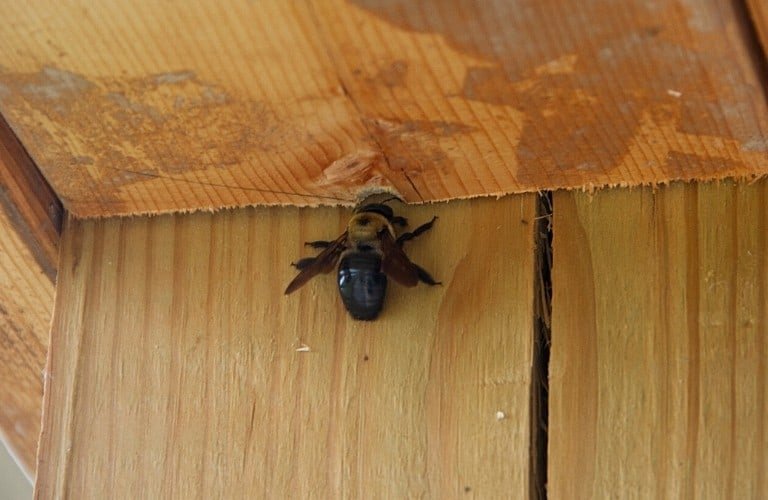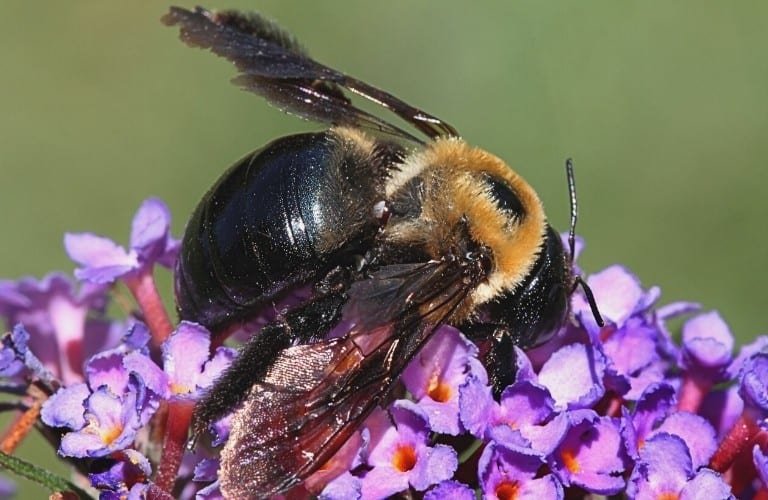You’ve probably heard of several different home remedies for getting rid of carpenter bees.
One of the strange ones is to spray their nests with some WD-40. Yes, that’s the stuff you use on squeaky door hinges.
Will WD-40 kill carpenter bees? WD-40 will kill carpenter bees and just about every other kind of insect. It contains mineral spirits, which is a type of petroleum liquid that’s toxic if consumed or touched in large quantities. For insects, it doesn’t take much, and it will kill them in about five minutes.
In the following, you’ll learn more about how WD-40 can be used as a pesticide and whether or not it’s truly an effective method.
We’ll also show you a few other ways to get rid of carpenter bees using items you likely have on hand.
Did you know that there are several ways to protect your property from damage without needing to kill the bees? See our full lineup of carpenter bee articles to explore your options.
A Quick History of WD-40
The blue and yellow can of WD-40 has an interesting background. The formula was first created in 1953 but wasn’t available to consumers until five years later.
It’s said that the name comes from the fact that it’s a water displacer and that it took 40 tries to perfect the formula. Thus, WD-40 got its name.
Original Purpose
WD-40 was meant to protect aircraft and rockets from rusting and corroding.
Airlines across America started using the product, and it eventually became available for everyday consumers to purchase.
At that point, it started to be used for similar reasons airlines were using it but for smaller items and on a smaller scale.
How It’s Used Today
When you hear a squeaky door, you probably pull out the blue and yellow can to fix it.
That’s the main use for it today, but it’s also used to loosen up stuck parts so they’ll move smoothly again.
These days, the Internet insists on making your life easier by providing life hacks. A simple search will reveal several interesting uses for WD-40, including:
- Removing carpet stains.
- Preventing wooden tool handles from splintering.
- Make your shoes waterproof.
- Make bird feeders too slippery for squirrels.
- Remove gum from your hair.
- Remove paint from your car.
- Get a ring off your finger.
The list goes on, but one of the things you’ll hear frequently is that you can use it to kill carpenter bees and prevent them from building nests in your house.
What’s WD-40 Made With?
You’re probably wondering what’s inside of WD-40 if it can kill bees but also carry out a thousand other functions. What kind of chemicals make it so powerful?
Well, the exact recipe is a secret because they never patented the product, and it’s even said that the original recipe is locked away in a safe in California.
What we do know is that it contains the following:
- 45-50% isoparaffin.
- Less than 35% of petroleum base oil.
- Less than 25% of a flammable version of isoparaffin.
- About 3% of carbon dioxide, which acts as a propellant.
WD-40 promises that it doesn’t contain:
- Water.
- Kerosene.
- Silicone.
- Graphite.
- Chlorofluorocarbons (CFCs).
WD-40 as Pest Control
If you need a quick way to get rid of some carpenter bees, WD-40 is certainly a quick way to go about it, and it’s super convenient if you have some on hand.
It will also serve as a repellent to prevent them from using your house to build their nests.
Using WD-40 as a Repellent
If you want to repel bees, spray your home where there is exposed, untreated wood.
Carpenter bees rarely choose to live in wood that has been stained, painted, or treated with any kind of product.
(That’s just one of the many tips you’ll find in our article “How To Get Rid of Carpenter Bees.” Be sure to check it out to learn how to protect your property.)
Occasionally a carpenter bee might not be too picky, so you can spray all the exposed wood if you want to be cautious.
Since bees don’t like treated wood, the WD-40 will prevent them from nesting.
If they come into contact with it, it will kill them in just a few minutes, so they’ll most likely die if they try it.
Did you know that not all carpenter bees are yellow and black? Some are solid black, and the blue carpenter bee has a lovely blue thorax!
Using WD-40 as a Pesticide
If you have bees currently living in your home, deck, or other pieces of wood, you can use WD-40 to kill them while they’re living there.
The female bees that live in the nest have stingers, and they’ll sting you if they feel threatened, so it’s best to spray their nest when they aren’t in it.
They forage in the morning, so that’s probably the best time.
Spray the WD-40 directly into the nest. The cans come with a long nozzle, so you should be able to fill the entire nest.
The bees should die within just a few minutes. If you still notice bees in the area after a few days, apply it again and continue to do so until the area no longer has any bees.
What Ingredient Kills the Bees?
Mineral spirit is a toxic chemical that’s inside of WD-40. It’s a form of petroleum that’s toxic in large amounts.
For humans, small amounts of mineral spirits are considered to be irritants whether the product touches the skin, is inhaled, or eaten.
If large amounts are consumed or touched, however, it can be incredibly toxic.
Carpenter bees are rather small. So, the small amount of mineral spirit in a squirt of WD-40 might not hurt us, but it can be enough to harm the bee severely.
A generous amount can kill the bee in just a few minutes.
Keep in mind that this also works for other insects. Ants, roaches, spiders, and bedbugs – just to name a few – will all die if they come into contact with WD-40.
Is WD-40 a Good Form of Pest Control?
To spray or not to spray? It’s certainly efficient, but it’s not the best option. It’s not environmentally friendly since it contains petroleum, which is a fossil fuel.
If you spray it on your house, you risk it running off into the ground when it rains and washes away.
It’s also incredibly flammable. If you live in an area that experiences droughts frequently, you may not want to use it outdoors since grass fires can spread.
If your home is covered with a flammable product, the drought season will be even more dangerous than usual.
(In this article, we show you how to lure carpenter bees away from your home to a more suitable location.)
Other Home Remedy Solutions
Many people like the idea of using WD-40 to kill carpenter bees because it’s convenient and won’t cost much.
If you’re out of it or would like to find a different home remedy, there are several other resources to choose from.
- Essential oils: Almond oil (here on Amazon) and citrus oil (this set has three different scents) are good repellents. They won’t kill bees, but they’ll cause a quick evacuation. Drop almond oil directly into their nests, or mix citrus oils with water to make a spray.
- Boric acid: Mix one part boric acid with three parts water. Mix well and spray their nests thoroughly. Boric acid (like this pure powder) is a natural pesticide that won’t harm the environment. The bees should die within an hour.
- Wet-vac: If you have a wet-vac, you can vacuum up the bees in the evening once they’re back in their nests. The bees might be able to escape, so try sprinkling boric acid inside the vacuum first.
Pre-Made Carpenter Bee Sprays
While the home remedies listed above will work, they might not be as fast-acting or convenient as what you had in mind. In that case, here are some effective pre-made solutions you can quickly pick up on Amazon.
| Preview | Product | Rating | |
|---|---|---|---|

|
Mighty Mint Peppermint Oil Insect Repellent Spray... | Check Price on Amazon |
Carpenter Bee Traps
Once you’ve gotten the initial issue handled, it’s a good idea to set a trap to attract future bees and keep them from nesting in the wood on the outside of your home.
| Preview | Product | Rating | |
|---|---|---|---|

|
RESCUE! VisiLure® TrapStik for Wasps, Mud... | Check Price on Amazon |
Consider Relocation
Carpenter bees are on the brink of being endangered.
While they can certainly be a frustrating pest to have around the home, they do serve a critical purpose in the world.
They’re native to the areas they live in, so they’re usually responsible for pollinating native plants. They’re beneficial in gardens because they’re responsible for making plants grow.
If you have a bee problem, consider calling a relocation service or attracting them to a different part of your yard.
They like untreated wood, so setting up a post with a bee house is a great way to get them away from the areas you don’t want them.
This bee house is affordable, features replaceable paper inserts for the 96 nesting tubes, and is made from sustainable pine materials.
- Removable 5" Mason Bee Nesting Tubes: Replace as needed each season; Rivajam bee supplies available.
- Our bee-friendly wax coating helps protect your wooden bee house & the Mason Bees from the weather.
Final Thoughts
WD-40 will kill carpenter bees and is an easy way to get rid of them if they’re becoming a problem.
You’ll need to work quickly since the females can sting, but it can still be an effective solution if you spray their nests with it when they’re not around.
Although carpenter bees do drill holes into wood around your property, they are beneficial to have around as well.
Read our article “Are Carpenter Bees Good or Bad?” before you take drastic action against them.




